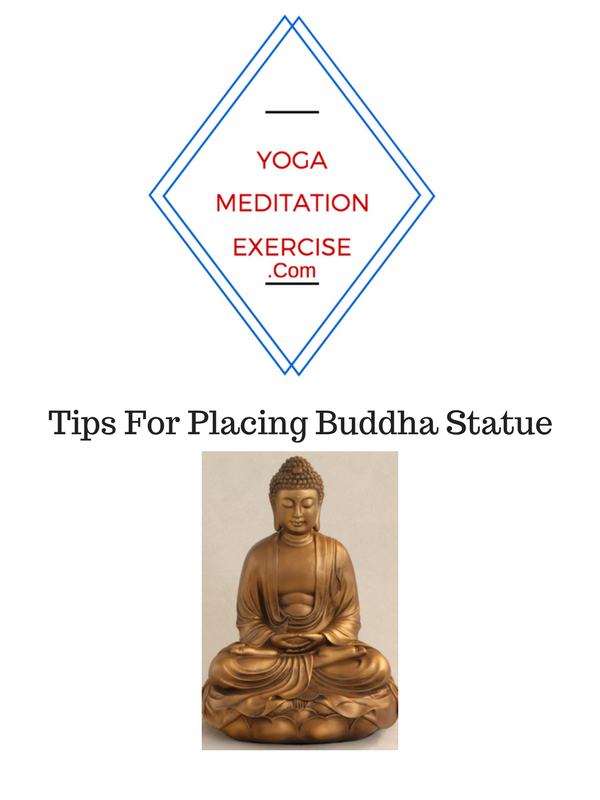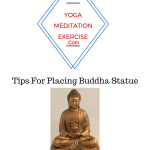Tips For Placing Buddha Statue
Within Buddhists circles, you’ll typically find various types of Buddha statues. Their homes and gardens have special sections where these statues reside and allow for some peaceful praying. But it doesn’t mean you have to be a Buddhist in order to enjoy these magnificent statues. If done correctly, you can bring them into your home and garden to create a very calming and relaxed atmosphere. And if you’re worried about the statues standing up against the elements, there are specific designs for outdoor use. You just have to look in the right places.

What A Buddha Statue Represents
Once you start searching for that perfect Buddha statue, you’ll realize just how many types and variations there are. In fact, each one brings with it a different symbolic meaning and purpose. For example, individuals who are focused on feng shui practices will get a statue that assists with energy movement inside your home. Everything depends on what you need, and where you need it.
Appropriate And Inappropriate Places For The Statue
When buying a Buddha statue, it’s understood that you are buying it with respect towards the culture. Even if you don’t share their views or principles, it is ultimately a universal symbol of spiritualism and peace. And if you’re looking for this type of statue, it says a lot about the calm and peaceful person you aim to be.
Inappropriate Placements:
– Directly on the ground
A Buddha statue should never be placed directly on the ground, as this is considered disrespectful. Neither should it be placed in the bathroom.
– The Bedroom
It’s not appropriate to have the statue in your bedroom, unless it’s given a spot within a cabinet with the doors closed. The only time the doors should be open is when you meditate.
Appropriate Placements:
– Entrance of the home
When placed at the entrance of the home, it should be facing the entrance and towards incoming guests.
– Facing Your Room
When placed in another part of the house, make sure it’s facing your room.
– Facing Your Home
If placed outside in the garden, let the statue face in the direction of your home. It is believed to bring great abundance.
Buddha Statue Buying Options For Interior And Exterior Use
– Feng Shui Imports:
In terms of maintaining a healthy energy flow inside the home, you are at liberty to choose from a wide range. You’ll discover different styles and even sizes, providing you with endless options. In fact, you can add a Buddha fountain if you like as well.
– Buddha Grove:
These are statues that can be utilized inside the home or outside in the garden. They range from miniature sizes, which are perfect if you want to display them via a shelf or table, to bigger models with a little more substance so-to-speak. Some of the statues even have an artistic finish, increasing the odds of you finding that special Buddha Statue.
– Buddha Gallery:
At the Buddha Gallery you’ll be provided with an option of antiuque statues. And what makes it even more interesting is that they gallery features collections from around the world. If you have a preference as to the country you want your antique Buddha statue has to come from, this is the place to do it.
All The Types Of Buddha Statues
– Statue for Meditation
The meditation statue is the most common in homes and gardens, and it’s molded in a very distinct position most people will recognize. This Buddha statue will be in a sitting position, hands placed in the appropriate meditation technique known as cosmic mudra. In other words, the hands cross with the left above the right, allowing thumb tips to connect and ultimately form an oval. This symbolizes focusing the energy inward.
The placement for this statue should be due east, seeing as Buddha used the morning sun to find answers to his many questions. It’s also said that good fortune will find you when you rub the statue’s belly.
Buddha Laughing
The laughing Buddha should look very familiar to western culture, because it’s also one of the favorites in the United States. This particular statue has an enormous belly, indicating abundance. His smile is a sign of happiness and leading a happy life as he got older.
Buddha will either be sitting or standing, while holding what is referred to as a Ru-Yi pot above his head. Sometimes it’s imaginary, and sometimes it’s real. Either way, it also represents abundance, and overall good luck.
It’s no surprise why this statue is better known as Happy, and the consequences of rubbing its belly comes in the form of more good luck and abundance. It’s recommended to place laughing Buddha in a south-east section of your home, or wealth corner if you prefer.
The Different Variations
Laughing Buddha and children: This statue should be placed in the west section of your garden or home.
Traveling Buddha: The statue is a combination of the laughing Buddha, depicted as a monk with a sack slung over his shoulder. Alternatively, the sack is tied to a stick, while he holds a wealth ball in the opposite hand. Suitable for the north sector inside your office.
Sprititual Journey Buddha: An atlernative version to the Traveling Buddha. Distinct differences include the gourd that’s tied to the stick he’s holding, the prayer beads he’s wearing, and the fan in the opposite hand. When placed in the north-east sector it will promote education. In a south-west sector it will have a positive influence on love and relationships. Check out these Buddhas from Outdoor Art Pros.
Blessing Buddha:
This statue takes on a “blessing pose”, with Buddha’s one hand raised and the other lowered. While in this position he’ll grant you fearlessness. It’s perfect for the office or den inside your home.
Teaching Buddha:
Also referred to as Dharma Chakra Buddha, you can find this Buddha sitting or standing. Although, the sitting position is the most popular, given Buddha’s preference to sit while teaching. It represents the most enlightentend time of his life, and when he was at the peak of sharing his experience and knowledge.
You’ll notice his hands in front of his chest, with the index fingers and thumbs connecting to make a circle. It’s because his teaching always came from the heart, and his teachings were directed at the Wheel of Dharma (union of wisdom and method). As for the remaining fingers, they are always extended.
Whether you’ll be using it inside the home, garden or office, the best place is a north-east sector.
If it happens that that the thumb connects with the ringfinger instead of the index fingers, the symbolism changes to increased fortune. For career focus, place the statue in a north sector, while south-east is perfect for wealth.
Long Life Buddha
You will either find this Buddha holding a bag near his side, or within his lap. Inside this bag is blessings, and when the bag is on his lap, he’ll be holding a Ru-Yi pot in one hand, and a wealth ball in the other. Regarding placement, east represents health, west is for children and descendants, while south-east represents wealth.
Happy Home Buddha
This is relationship statue, and can be used inside or outside within a sout-west area.
Earth Buddha
This statue sits on the ground and points to the earth via the extended fingers on the right hand. It represents his victory over temptation from the demon, Mara, and it will help for relationships when placed in a south-west area. For career difficulties and a lack of motivation, place it in the north section of your home or garden.
Reclining Buddha
The Reclining Buddha statue is perfect for any transition periods you are going through, because it represents Buddha’s journey between life and death. More specifically, it represents his transformation into another being.
The best place for this statue is the room that defines your transition so-to-speak. For instance, if you are going through a job transition, you want it in a north area inside your home or office. For those who just ended a relationship, the south-east area is best, while new home owners should use it in a west area.



